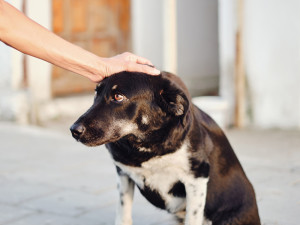Dog Senses: What Are Dogs’ Strongest Senses?
That little nose sure works well...

Share Article
In This Article:
Can Dogs Sense Pregnancy?opens in a new tab Smell: How Strong Is A Dog’s Sense of Smell?opens in a new tab Taste: How Many Taste Buds Do Dogs Have?opens in a new tab Sight: What Does a Dog’s Eyesight Look Like?opens in a new tab Hearing: How Far Can Dogs Hear?opens in a new tab Touch: Why Does My Dog Always Have To Be Touching Me?opens in a new tab
There are so many incredible stories about dogs who seem to be aware of something big happening long before their pet parents have the first inkling of a change. At times, it almost seems to verge on supernatural abilities. And while you may prefer to think of your pup as a superhero, if you are a person of science, you may be looking for more plausible explanations, too.
Many times, dogs’ incredible abilities can be chalked up to their incredible senses, which are often far superior to ours. This is especially true of their senses of smell and hearing. In addition to the standard five senses, dogs also have very keen observational skills, especially when it comes to their favorite people. They become experts in our body language and routines. This allows them to sense change long before we think we are acting differently. Read on to learn all about how dogs sense the world and how that leads to their hyper awareness and unbelievable abilities.

littleKin™ is Kinship’s home just for puppy and kitten parents. Bop over to check out expert advice, new pet tools, and special deals—all curated for your newest family member.
opens in a new tabMain takeaways:
Dogs have many highly attuned senses, including their senses of smell and hearing.
Dogs also have some unique traits when it comes to their sense of taste and vision.
Many of these senses make dogs the perfect match to help humans in a number of different professions in addition to being great companions.
Can dogs sense pregnancy?
There are many anecdotal reports from women claiming that their dog seemed to know they were pregnant long before they had a positive test. Many times, pet parents report that their dog starts acting more clingyopens in a new tab, and maybe even insists on resting on their belly. While there have not been any specific scientific studies to date that test whether or not a dog can sense pregnancy in humans, it seems very likely to be true.
For one thing, there are many documented examples of dogs sensing subtle changes in smell that coincide with hormonal changes. They can accurately sense when female dogs are biologically receptive to mating. Dogs have also been able to sense when dairy cows are in heat, proving that this ability extends beyond their own species. When it comes to pregnant human women, dogs may be picking up on a number of cues. There may be changes in scent they can detect based on pregnancy hormones. They may also be using their keen observational skillsopens in a new tab to pick up on changes in behavior, routine, or emotions. All of this can make a dog acutely aware that a big change is coming, well before we humans are conscious of it.
Smell: How strong is a dog’s sense of smell?
A dog’s sense of smellopens in a new tab is extremely powerful and may be their most influential sense. It’s reported that a dog’s sense of smell is somewhere between 10,000 to 100,000 times more sensitive than that of humans. They can detect the scent of a person for up to 48 hours after they have left a particular location and can also detect the presence of many chemical compounds at very dilute concentrations, far below a level that humans can smell.
This has led dogs and humans to team up in many different fields of detective work. Dogs are often used in search and rescue operations to help search for people who may be buried under rubble or in remote locations. They are also employed to sniff out substances like illegal drugs and dangerous chemicals. Their sniffers have even been put to use in wildlife conservation to detect the presence of certain endangered animals, like the San Joaquin kit fox, the Kakapo, and the Aleutian cackling goose, to help protect them. Finally, dogs have been employed to sniff out a variety of medical conditions in humans including early detection of certain cancers, low blood-sugar in diabetic patients, and seizures in epileptic patients. Their abilities to detect these conditions long before humans are aware of them can be life-saving for many individuals.
Taste: How many taste buds do dogs have?
Taste is one sense where you may be able to out-sense your pup. While dogs can taste all five basic flavors, their overall sense of taste is more muted than ours. Like us, dogs have taste receptors for sweetopens in a new tab, salty, sour, bitter, and umami flavors. However, while we have around nine thousand taste receptors in our mouths; dogs only have about 1,700 on average.
This means that they are not likely to appreciate subtle flavor profilesopens in a new tab. It also means that even when they don't like the taste of something, they may try it a few times before they swear off it altogether. They are known to be less sensitive to salt compared to other species as well. And while you may be able to taste things your dog thinks are invisible, keep in mind that smell has a huge influence on taste. Dogs can certainly out-smell our noses, which informs their taste and eating experience in another dimension.
Sight: What does a dog’s eyesight look like?
There are a number of anatomical differences between a dog’s eyes and our eyes which influence how they see the worldopens in a new tab. First, most dogs’ eyes are positioned on the sides of their heads, as opposed to the front, and this affects their field of vision. As a result, they can see a wider range of their surroundings but have a smaller overlap of binocular vision, where both eyes visualize the same field. This means that their depth perceptionopens in a new tab is not as sharp as ours.
Additionally, within the retina at the back of the eye, dogs have a different arrangement of rods and cones than humans. They tend to have more rods than cones overall, which helps them see better in dim light or dark surroundings. They also have only two kinds of cones, compared to the three that humans have, making their color vision duller than ours.
Finally, they have an additional reflective surface on the back of their eye, called the tapetum, which also helps their eyes to capture light and see in the dark. It’s also the reason why your dog’s eyes might look like tiny lasers if you try to take a photo of them using a flash. Overall, dog vision is best suited for seeing a larger overall area, seeing in the dark, and seeing fast-moving objects, while we have the better vision for details and colors.
Hearing: How far can dogs hear?
Dogs are also known for their sensitive hearingopens in a new tab and ability to hear sounds that humans cannot appreciate. This may be due to a number of factors. In general, dogs can hear a greater range of sounds than humans, with dogs hearing sounds in the frequency of 65-45,000 Herz and humans limited to a range of 20-20,000 Herz. They can also hear sounds that are up to four times further away than what humans can hear, up to about 400 meters away. And, they are better at localizing sound, or finding the source of sound. This is likely due in part to the design of dogs’ ears including the large size of their outer ears, or pinnae, and their ability to move their outer ears independently of one another and in the direction of sounds that they are hearing.
Of course, when you look at different dog breeds across the species, ear shape is one of the most variable traits. While some dogs like German Shepherds have huge ears that stand up on top of their heads like little satellites, other breeds like basset hounds have long droopy ears that may actually muffle sounds. A dog’s hearing may be highly influenced by these aesthetics so don’t assume every dog has super hearing but they might still be ignoring you when you call them from the next roomopens in a new tab.
Touch: Why does my dog always have to be touching me?
Sense of touch is experienced in unique ways for dogs. First, dogs have highly sensitive whisker-like projections on their face, known as “vibrissae,” that form a highly sensitive tactile sensory system. These hairs are believed to play many important roles in helping animals stay oriented in space, find their way in the dark, keep their balance, and sense their surroundings. Compared to humans, dogs also have a more dull sense of touch on their digits. While humans have highly-sensitive tactile senses in their fingertips, dogs have fewer tactile receptors in their paw pads.
In general, touch is a powerful sense for both humans and dogs when it comes to bonding, even if it is perceived in different ways. Touch is the first sense to develop in newborn puppies before their eyes or ears even open. They use touch to sense where their mother is and seek out her warmth. Enjoyable physical touchopens in a new tab also stimulates the release of oxytocin and prolactin, which cause both animals and people to feel calm, happy and safe. This explains why dogs seek out the gentle touch of their favorite people, and why petting dogs is well-documented to improve human well-being too. It’s an interspecies win-win.
The bottom line
The five senses provide important feedback about how dogs interpret their world.
Dogs have uniquely powerful senses of smell and hearing.
Sense of touch is important for both dogs and humans and is one of the most powerful ways for the species to bond.
References
Barber, ALA, et al. “A comparison of hearing and auditory functioning between dogs and humansopens in a new tab.” Comparative Cognition and Behavior Reviews, vol. 15, January 202, pp. 45-94.
Becker, Marty. “Touch is not a wantopens in a new tab.” Veterinary Practice News, 14 February 2022.
Jenkins E.K., et al, “When the Nose Doesn't Know: Canine Olfactory Function Associated With Health, Management, and Potential Links to Microbiota.opens in a new tab” Frontiers in Veterinary Science, vol. 5, no. 56, 29 March 2018.
Kiddy C.A., et al, “Detection of Estrus-Related Odors in Cows by Trained Dogsopens in a new tab.” Biology of Reproduction, 1978, vol. 19, pp. 389–395.
Kokocińska-Kusiak A, et al. “Canine Olfaction: Physiology, Behavior, and Possibilities for Practical Applicationsopens in a new tab.” Animals (Basel), 2021, vol. 11, no. 8, 21 August 2021, pp. 2463.
Pickel, Duane, et al, “Evidence for canine olfactory detection of melanomaopens in a new tab.” Applied Animal Behaviour Scienceopens in a new tab, vol. 89, no. 1-2, November 2004, pp. 107-116.
Spense, Charles. “Gastrophysics for pets: Tackling the growing problem of overweight/obese dogsopens in a new tab.” Applied Animal Behaviour Scienceopens in a new tab, vol. 256, November 2022, pp. 105765.

Dr. Amy Fox, DVM
Amy Fox, DVM is a small animal veterinarian in New York City. A lifelong animal lover, Dr. Fox studied biology in college and then worked as a veterinary nurse before pursuing veterinary school at Cornell University. She has worked in many different settings including shelter medicine, emergency medicine, general practice, and animal cruelty and forensics. She is especially interested in nutrition, preventative medicine and care for senior pets. Dr. Fox also enjoys writing about veterinary medicine and teaching. In her free time she loves to cook, garden, and go for long runs.
Related articles
- opens in a new tab
Can Dogs Taste Sugar?
We already know they’re sweet.
- opens in a new tab
Can Dogs Taste Spice, and Do They Enjoy Eating Spicy Foods?
![Jack Russell Terrier in a yellow raincoat walks through the autumn park.]() opens in a new tab
opens in a new tabDogs’ Sense of Smell: What Can Dogs Smell?
There’s a reason that sweet little nose is always pressed to the ground.
![a small dog looking disgusted]() opens in a new tab
opens in a new tab6 Scents Your Dog Probably Can’t Stand
A dog’s sense of smell can be 100,000 times stronger than a human—so when it’s bad, it’s bad.
![Dog that looks unhappy being patted on the head by someone's hand while sitting on pavement outside]() opens in a new tab
opens in a new tabUh, Why Doesn’t My Dog Like Getting Pet?
“No touch-y!”
![Dog Looking Out The Window.]() opens in a new tab
opens in a new tabDog Vision: What Do Dogs See?
Those soulful eyes mean everything to you—learn all about them.








